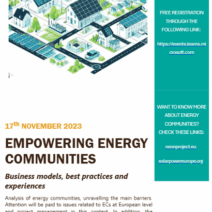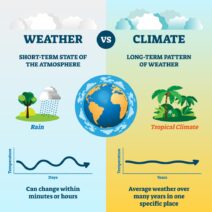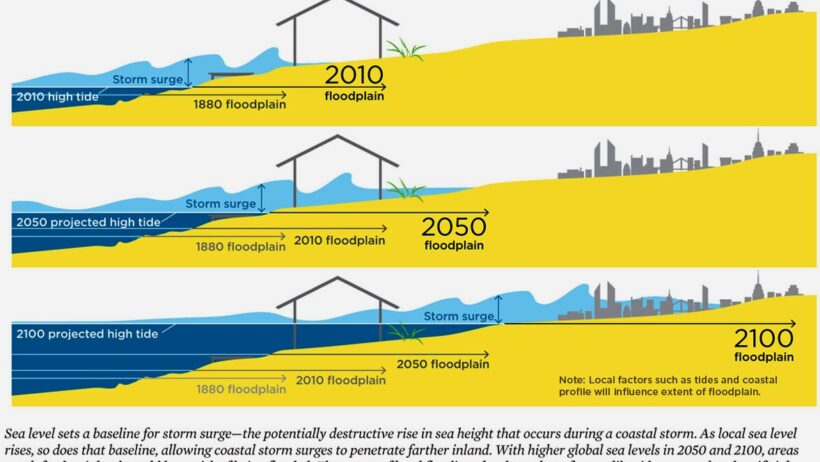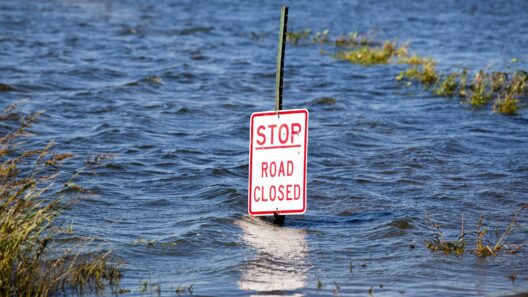Rising sea levels are a phenomenon that cannot be ignored, evoking both curiosity and trepidation. Our fascination with this issue often stems from its tangible consequences: eroding coastlines, flooding homes, and submerging ecosystems, all shaped by the relentless force of climate change. To understand the gravity of rising sea levels, we must delve into the interconnected nature of global warming and this geographical transformation. This exploration reveals a path laden with complexities, imperatives, and urgent actions that beckon humanity to address them before it’s too late.
In this article, we shall examine how rising sea levels affect climate change through a multidimensional lens, analyzing the feedback mechanisms, the socioeconomic ramifications, and the potential solutions to mitigate this impending crisis.
Understanding the Mechanisms: How Rising Seas Propel Climate Change
Rising sea levels are predominantly the result of two main factors: thermal expansion of seawater and the melting of ice sheets and glaciers. As global temperatures rise due to anthropogenic emissions of greenhouse gases, seawater expands. This thermal expansion alone accounts for a significant portion of the observed sea level rise. Furthermore, the melting of polar ice sheets in Greenland and Antarctica contributes massively to this phenomenon, releasing vast volumes of freshwater into the ocean, further exacerbating the situation.
One might ponder, “How does this interplay between warmer oceans and melting ice affect climate change?” The answer lies in the feedback loops that emerge from rising sea levels. For instance, as sea levels rise, coastal wetlands and mangroves that usually buffer storms and absorb carbon are increasingly submerged. Consequently, this diminishes their capacity to sequester carbon, thereby elevating atmospheric CO2 concentrations, which further accelerates global warming.
Moreover, as coastlines retreat and saltwater intrudes into freshwater systems, ecosystems suffer. Aquifer salinization not only compromises water resources but also disrupts agriculture by affecting crop yields, further aggravating food insecurity and poverty. This unravels the delicate fabric of social and economic systems, creating a cascading effect that leaves vulnerable populations even more exposed to the repercussions of climate change.
The Socioeconomic Tidal Wave: Impacts on Communities and Economies
The ramifications of rising sea levels extend well beyond environmental consequences; they encroach upon the very heart of human civilization. Low-lying coastal cities are at the forefront of this battle, with communities facing existential threats. Places like Miami, New Orleans, and large parts of Bangladesh are witnessing firsthand the encroachment of the sea, as floods become more frequent and severe. Communities are left with compelling choices: adapt, relocate, or, tragically, succumb.
Moreover, these socioeconomic impacts disproportionately affect marginalized communities who often lack the resources to defend themselves against the onslaught of flooding and displacement. Those residing in precarious housing often bear the brunt of climate impacts, facing heightened risks of homelessness and loss of livelihood. This creates a myriad of additional challenges ranging from increased healthcare costs to loss of economic productivity.
Insurance markets are also grappling with the implications of rising sea levels. As properties become uninsurable or lose value, a ripple effect occurs that not only destabilizes local real estate markets but also inhibits economic growth. Businesses that once thrived in coastal cities are now reassessing their location viability, leading to stalled investments and foregone opportunities.
Ultimately, the socioeconomic burden stemming from rising sea levels reveals an integral truth: climate change is not merely an environmental issue; it is inextricably linked to social justice, equity, and human rights. Our planet’s warming trajectory calls for an unequivocal response that addresses the human dimension of the climate crisis.
Charting a Course for Solutions: Mitigation and Adaptation Strategies
While the challenges posed by rising sea levels may seem insurmountable, humanity possesses the ingenuity and resilience to confront this crisis head-on. The dual approach of mitigation and adaptation is vital. Mitigation involves reducing greenhouse gas emissions through a transition to renewable energy sources such as wind, solar, and hydropower. This transition not only curtails future contributions to climate change but also paves the way for sustainable development.
Adaptation strategies, on the other hand, emphasize resilience in the face of inevitable change. These approaches include the construction of sea walls, restoration of coastal ecosystems such as mangroves and wetlands, and the development of sustainable urban infrastructure. Bolstering community resilience also requires inclusive planning processes that ensure the voices of marginalized populations are not just heard but prioritized in decision-making.
International collaboration is paramount in addressing this global crisis. Robust agreements, such as the Paris Agreement, serve as a framework for collective action, promoting cooperation among nations to reduce emissions, share technology, and support vulnerable regions. Empowering local communities to take ownership of adaptation efforts and fostering education on climate resilience can enhance our collective capacity to withstand the future tides.
In conclusion, rising sea levels and climate change are two intertwined phenomena that demand urgent attention and action. By understanding the mechanisms at play, acknowledging the socioeconomic implications, and committing to holistic solutions, we can embark on a transformative journey. It is a journey not just of survival but of thriving amidst adversity, fostering a world where communities unite to embrace sustainability and equity as our guiding principles.








